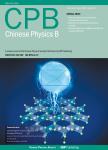Effects of carrier density and interactions on pairing symmetry in a t_(2g) model
Effects of carrier density and interactions on pairing symmetry in a t2g model作者机构:National Laboratory of Solid State Microstructures and Department of PhysicsNanjing UniversityNanjing 210093China Nanjing University of Science and TechnologyNanjing 210094China Department of PhysicsNanjing Normal UniversityNanjing 210023China Collaborative Innovation Center of Advanced MicrostructuresNanjing UniversityNanjing 210093China
出 版 物:《Chinese Physics B》 (中国物理B(英文版))
年 卷 期:2024年第33卷第1期
页 面:223-230页
核心收录:
学科分类:07[理学] 070205[理学-凝聚态物理] 0702[理学-物理学]
基 金:Project supported by the National Key Research and Development Program of China (Grant No.2021YFA1400400) the National Natural Science Foundation of China (Grant Nos.92165205,12074175,and 12374137)
主 题:unconventional superconductivity pairing mechanism Fermi surface three-orbital model
摘 要:By utilizing the fluctuation exchange approximation method,we perform a study on the superconducting pairing symmetry in a t_(2g) three-orbital model on the square *** the tight-binding parameters of the model are based on Sr_(2)RuO_(4),we have systematically studied the evolution of superconducting pairing symmetry with the carrier density and interactions,making our findings relevant to a broader range of material *** a moderate Hund’s coupling,we find that spin fluctuations dominate the superconducting pairing,leading to a prevalent spin-singlet pairing with a d_(x^(2)-y^(2))-wave symmetry for the carrier density within the range of n=1.5-4 per *** reducing the Hund’s coupling,the charge fluctuations are enhanced and play a crucial role in determining the pairing symmetry,leading to a transition of the pairing symmetry from the spin-singlet d_(x^(2)-y^(2))-wave to the spin-triplet ***,we find that the superconducting pairings are orbital *** the carrier density changes from n=4 to n=1.5,the active orbitals for superconducting pairing shift from the quasi-two-dimensional orbital dxy to the quasi-one-dimensional orbitals d_(xz) and d_(yz).



